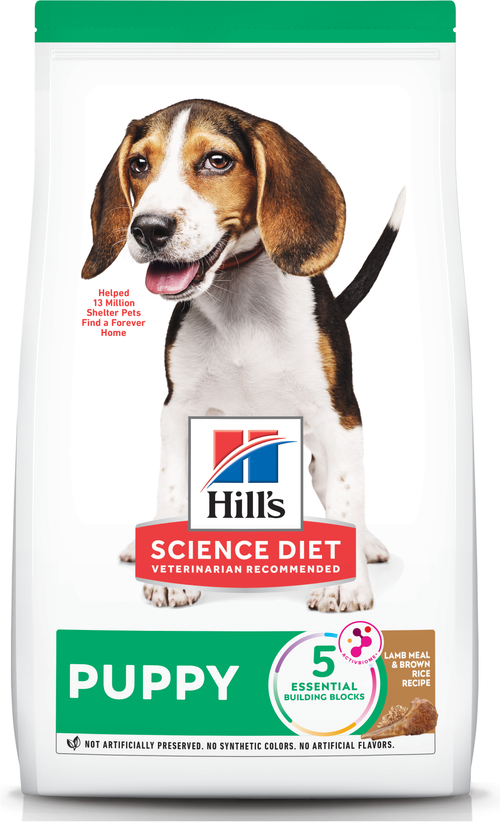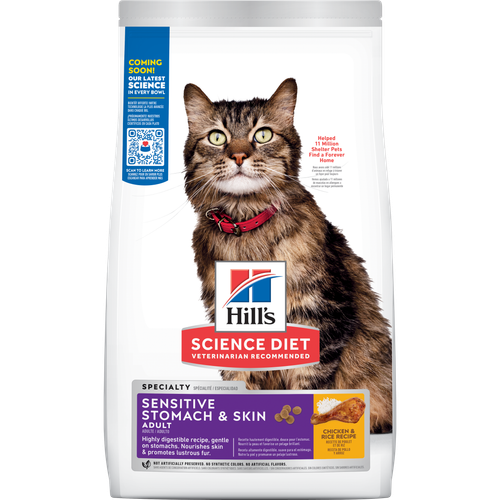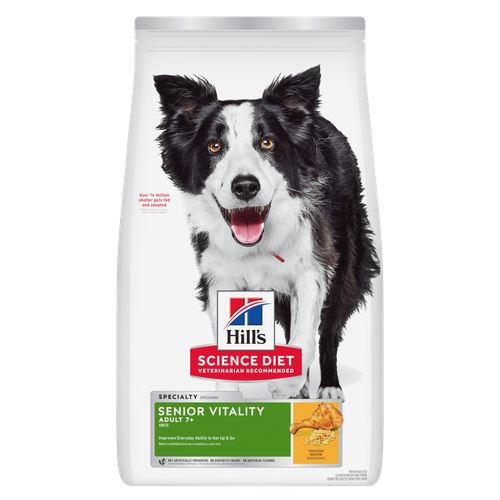
-
Find the right food for your petTake this quiz to see which food may be the best for your furry friend.Find the right food for your petTake this quiz to see which food may be the best for your furry friend.Featured products
 Puppy Lamb Meal & Brown Rice Recipe
Puppy Lamb Meal & Brown Rice RecipeVital nutrients to support 5 essential building blocks for lifelong health
Shop Now Puppy Large Breed Chicken & Brown Rice Recipe
Puppy Large Breed Chicken & Brown Rice RecipeVital nutrients to support 5 essential building blocks for lifelong health
Shop Now Hill's Science Diet Adult 7+ Senior Vitality Small & Mini Chicken & Rice Recipe Dog Food
Hill's Science Diet Adult 7+ Senior Vitality Small & Mini Chicken & Rice Recipe Dog FoodImproves everyday ability to get up & go
Shop NowFeatured products Adult Sensitive Stomach & Skin Cat Food
Adult Sensitive Stomach & Skin Cat FoodHighly digestible food that is gentle on the stomach. Nourishes skin & promotes lustrous fur.
Shop Now Adult Indoor Chicken Recipe Cat Food
Adult Indoor Chicken Recipe Cat FoodSupports energy level and beautiful fur in indoor cats
Shop Now Adult 7+ Chicken Recipe Cat Food
Adult 7+ Chicken Recipe Cat FoodSupports energy level and beautiful fur in mature cats
Shop Now -
Dog
- Dog Tips & Articles
-
Health Category
- Weight
- Food & Environmental Sensitivities
- Urinary
- Digestive
- Joint
- Kidney
-
Life Stage
- Puppy Nutrition
- Adult Nutrition
Cat- Cat Tips & Articles
-
Health Category
- Weight
- Skin & Food Sensitivities
- Urinary
- Digestive
- Kidney
-
Life Stage
- Adult Nutrition
Featured articles Pet Food Storage Tips
Pet Food Storage TipsDiscover how and where to store your dry, as well as canned, dog and cat food. Learn how to find the "best before" dates on all Hill's pet food packaging.
Read More The Incredible Science Behind Your Pet's Microbiome
The Incredible Science Behind Your Pet's MicrobiomeLearn what a pet's microbiome is, how it contributes to your pet's gut & overall health, and why nutrition is important in maintaining healthy microbiomes.
Read More Water
WaterDiscover why water is the most important nutrient for your dog or cat to live a healthy life. Find out how much water your pet should consume each day.
Read More -


Many people think that because their dog isn't yelping out or holding a paw up that he isn't in pain, but this simply isn't true. While dogs may yelp or limp in response to pain, joint problems in dogs often have subtler signs, and are missed by even the most well-intentioned pet parents. "Slowing down" is not a natural consequence of aging, so if your dog is limping along, it's time to find him some help.

Signs of Joint Problems in Dogs
How do you know if your dog is in pain? Any and all of the following can be signs of chronic discomfort due to joint pain:
- Increased irritability
- Lagging behind on walks
- Slower to get up in the morning
- Stiffness, limping or "slowing down"
- Sleeping more
- Not enjoying games and walks like he used to
- Reluctance to jump into the car or go up or down stairs
- Excessive licking of a sore joint
- Swollen joints
- Muscle loss
- Yelping when touched
- "Bunny-hopping" when running
Causes of Joint Pain in Dogs
So, what causes these joint problems in dogs? Typically, joint problems in dogs fall into two major categories: developmental and degenerative. Developmental occurs when the joint or ligament does not develop correctly causing it to not function as intended. Degenerative, on the other hand, causes the ligaments around your dog's joints to "degenerate" (or regress) over time. Similar to human's, your dogs joints need to be properly cared for (proper nutrition, stretching, proper exercise, etc.,) or they can start to breakdown and cause discomfort for your dog. According to PetCoach there are 7 other diseases that can affect your dog's joints:
- Ligament, tendon or muscle diseases that can tear or rupture over time
- Fractures at the joint
- Congenital (present from birth) disorders like Wobbler's syndrome or a luxated patella
- Dietary or hormonal disease
- Metabolic disorders
- Cancer
- Inflammatory joint disease such as Lyme disease or rheumatoid arthritis
Joint Pain Relief for Dogs
Fortunately, no dog has to suffer with chronic pain. Science has given us a whole host of options to lessen the pain associated with joint problems in dogs. If your dog has been diagnosed with joint pain, one of the best things you can do for him is make sure he is at a healthy weight. Obesity is a big problem in dogs, and the excessive load it places on your dog's joints exacerbates the signs of arthritis. An overweight dog hurts a lot more than a thin dog.
Weight loss alone can significantly reduce the signs associated with joint pain in many dogs. Ask your veterinarian if your dog should lose weight, and then work with your vet to design a weight loss plan if needed. If you have already started a weight loss program but you aren't getting anywhere, ask your vet about switching to a prescription food for weight loss.
Joint pain can also be controlled by the use of anti-inflammatory medication, such as carprofen, meloxicam, deracoxib, galliprant and other prescription pain medication. These medications are available via prescription only through your vet. You should never give your dog human pain pills or arthritis medication, or attempt to dose him yourself.
Supplements
Joint supplements are gaining traction and interest in the canine world as an alternative to prescription pain medication. Glucosamine hydrochloride, chondroitin and omega-3 fatty acids from fish oil are some of the more well-known and clinically tested supplements available for joint pain relief in dogs.
Not all joint supplements are created equally. Only buy supplements that your vet recommends to ensure safety and efficacy. Some therapeutic foods are specially formulated with joint health-boosting ingredients baked in, making administering supplements as easy as filling your pup's bowl.


Tasty Tips
The Future of Dog Pain Relief and Joint Care
Canine rehabilitation and sports medicine are two of the fastest growing segments of the veterinary market and for good reason. Vets certified in canine rehabilitation can help dogs walk again without pain, and the field is a wonderful alternative treatment for joint pain in dogs.
Rehabilitation uses a variety of treatment modalities and exercises to reduce pain, build muscle and increase flexibility in even the oldest dogs. Canine rehab specialists use everything from hydrotherapy (underwater treadmills), laser therapy, acupuncture, balance balls and massages to help reduce pain and build strength. Even investing in one or two sessions with one of these specialists may benefit your pooch, and allow you to learn some of the exercises to keep his muscles strong and his joints flexible.
Another area that is showing promise for providing joint pain relief in dogs is regenerative medicine. This is the stuff of the future! Two therapies — platelet-rich plasma (PRP, for short) injections and stem cell injections — have shown to provide relief to patients suffering from joint pain. The idea is that these treatments help reduce pain and inflammation in sore joints. According to the University of Missouri Veterinary Health Center, PRP is already established as a treatment for human osteoarthritis and an aid to joint replacement surgery.
Treatments for joint pain in dogs works best when multiple treatments are used together, such as a combination of medication, weight loss and joint supplements to treat canine arthritis. This approach is so effective that pain experts have coined a term for it: multimodal therapy, which means multiple modes of treatment. If you're curious about any of these options talk to your veterinarian about whether one is good for your dog.

What About Preventing Joint Problems?
Dogs with normal joints tend to give birth to puppies with normal joints. If you are getting a puppy from a breeder, ask to see the hip and elbow Orthopedic Foundation for Animals scores for the sire and dam (dad and mom), and look for a score of Good to Excellent. If you're adopting a lovable shelter mutt, ask the adoption center if they have any information on his medical or breed history.
Proper nutrition from the beginning is necessary to help prevent joint disease. Proper puppy nutrition is critical to good joint health. Even though genetics do play a role in some canine joint disorders, you may be able to minimize your puppy's risk of developing joint disease by feeding him the right amount of the right food, which means feeding large breed puppies a high-quality large breed puppy food, and working with your vet to determine the amount that is right for your dog.
Just because a dog has been diagnosed with joint problems doesn't mean the fun and games are over. There are so many ways to help treat and prevent joint problems in dogs. Talk with your vet about how to help your dog have a better quality of life today.


Dr. Sarah Wooten graduated from UC Davis School of Veterinary Medicine in 2002. A member of the American Society of Veterinary Journalists, Dr. Wooten divides her professional time between small animal practice in Greeley, Colorado, public speaking on associate issues, leadership, and client communication, and writing. She enjoys camping with her family, skiing, SCUBA, and participating in triathlons.
Related products

Vital nutrients to support 5 essential building blocks for lifelong health

Improves everyday ability to get up & go

Improves Everyday Ability to Get Up & Go

Vital nutrients to support 5 essential building blocks for lifelong health
Related articles

Learn basic steps & precautions for treating a cut on your dog, including what you can put on the cut, and when you should take them to the vet.

Learn how to stop your dog from begging at the dinner table, and understand how it can help contribute to his health.

Understand the role that Omega-6 and Omega-3 fatty acids play in your dog's overall health, and how you can ensure they are getting enough.

Discover fun and engaging games and other ways to help your dog exercise, keeping him happy and healthy.

Put your dog on a diet without them knowing
Our low calorie formula helps you control your dog's weight. It's packed with high-quality protein for building lean muscles, and made with purposeful ingredients for a flavorful, nutritious meal. Clinically proven antioxidants, Vitamin C+E, help promote a healthy immune system.
Put your dog on a diet without them knowing
Our low calorie formula helps you control your dog's weight. It's packed with high-quality protein for building lean muscles, and made with purposeful ingredients for a flavorful, nutritious meal. Clinically proven antioxidants, Vitamin C+E, help promote a healthy immune system.

